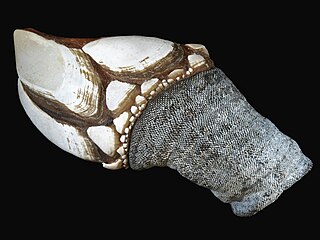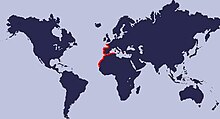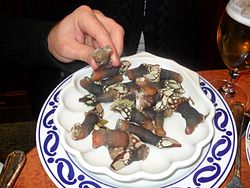
Barnacles are a type of arthropod constituting the subclass Cirripedia in the subphylum Crustacea, and are hence related to crabs and lobsters. Barnacles are exclusively marine, and tend to live in shallow and tidal waters, typically in erosive settings. They are sessile (nonmobile) and most are suspension feeders, but those in infraclass Rhizocephala are highly specialized parasites on crustaceans. They have four nektonic larval stages. Around 1,000 barnacle species are currently known. The name Cirripedia is Latin, meaning "curl-footed". The study of barnacles is called cirripedology.

Goose barnacles, also called stalked barnacles or gooseneck barnacles, are filter-feeding crustaceans that live attached to hard surfaces of rocks and flotsam in the ocean intertidal zone. Goose barnacles formerly made up the taxonomic order Pedunculata, but research has resulted in the classification of stalked barnacles within multiple orders of the infraclass Thoracica.

The Chthamalidae are a family of chthamaloid barnacles, living entirely in intertidal/subtidal habitats, characterized by a primary shell wall of eight, six, or four plates, lacking imbricating plate whorls, and either membraneous or more rarely calcareous basis. They are not found below immediate subtidal habitats, and more likely are found in the highest tier of shallow-water barnacle fauna. They can be found in the most rigorous wave-washed locations, and some species are found in the surf zone above high tide mark, only receiving water from wave action at high tide.

Anelasma is a monotypic genus of goose barnacles that live as parasites on various shark hosts.

Whale barnacles are species of acorn barnacle that belong to the family Coronulidae. They typically attach to baleen whales, and sometimes settle on toothed whales. The whale barnacles diverged from the turtle barnacles about three million years ago.

Austromegabalanus psittacus, the giant barnacle or picoroco as it is known in Spanish, is a species of large barnacle native to the coasts of southern Peru, all of Chile and southern Argentina. It inhabits the littoral and intertidal zones of rocky shores and normally grows up to 30 centimetres (12 in) tall with a mineralized shell composed of calcite. The picoroco barnacle is used in Chilean cuisine and is one of the ingredients in curanto.

Austromegabalanus is a genus of giant barnacles. It contains both extant and extinct species.

The Acrothoracica are an infraclass of barnacles.

Dosima fascicularis, the buoy barnacle, is "the most specialised pleustonic goose barnacle" species. It hangs downwards from the water surface, held up by a float of its own construction, and is carried along by ocean currents.
Calcinus tubularis is a species of hermit crab. It is found in the Mediterranean Sea and around islands in the Atlantic Ocean, where it lives below the intertidal zone. Its carapace, eyestalks and claws are marked with numerous red spots. C. tubularis and its sister species, C. verrilli, are the only hermit crabs known to show sexual dimorphism in shell choice, with males using normal marine gastropod shells, while females use shells of gastropods in the family Vermetidae, which are attached to rocks or other hard substrates.

Pollicipes is a genus of goose barnacles, first described by William Elford Leach in 1817. It comprises four species of marine suspension-feeders.

Lepas anserifera is a species of goose barnacle or stalked barnacle in the family Lepadidae. It lives attached to floating timber, ships' hulls and various sorts of flotsam.

Lepas anatifera, commonly known as the pelagic gooseneck barnacle or smooth gooseneck barnacle, is a species of barnacle in the family Lepadidae. These barnacles are found, often in large numbers, attached by their flexible stalks to floating timber, the hulls of ships, piers, pilings, seaweed, and various sorts of flotsam.

Pollicipes polymerus, commonly known as the gooseneck barnacle or leaf barnacle, is a species of stalked barnacle. It is found, often in great numbers, on rocky shores on the Pacific coasts of North America.

Megabalanus tintinnabulum is a species of large barnacle in the family Balanidae. It is the type species of the genus. The specific name comes from the Latin tintinnabulum meaning a handbell and probably refers to the fact that small groups of barnacles resemble clusters of miniature bells.

Megabalanus coccopoma, the titan acorn barnacle, is a tropical species of barnacle first described by Charles Darwin in 1854. Its native range is the Pacific coasts of South and Central America but it is extending its range to other parts of the world.

Baía de Tarrafal or Tarrafal Bay is a bay of the Atlantic Ocean on the northwest coast of the island of Santiago in Cape Verde. The town of Tarrafal lies at its southeastern shore, and 643 m high Monte Graciosa rises from its northern shore. Most of its coast is rocky, but there is a stretch of beach near the city. The headland Ponta Preta marks the northwestern limit of the bay; there is a lighthouse on it.
Oxynaspis gracilis is a species of goose barnacle in the family Oxynaspididae, commonly known as the black coral barnacle because it is normally found attached to black coral. The type specimen was found in Réunion in the East Indies.

Pollicipes caboverdensis is a species of goose barnacle in the family Pollicipedidae. It is found in rocky intertidal zones on the coasts of the islands Santiago, Sal and São Vicente, Cape Verde. The species was first described by Joana N. Fernandes, Teresa Cruz and Robert Van Syoc in 2010 after a 24.5 mm specimen collected from Ponta Preta, northwestern Santiago.

Conchoderma virgatum is a species of goose barnacle in the family Lepadidae. It is a pelagic species found in open water in most of the world's oceans attached to drifting objects or marine organisms.

















